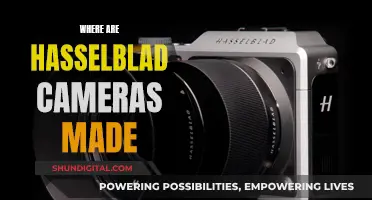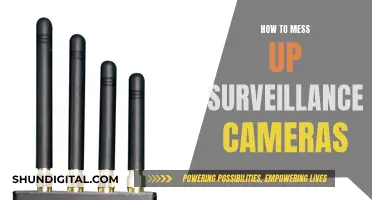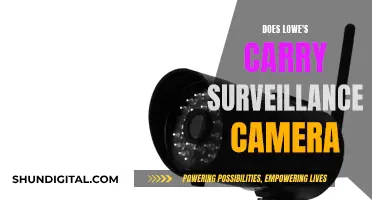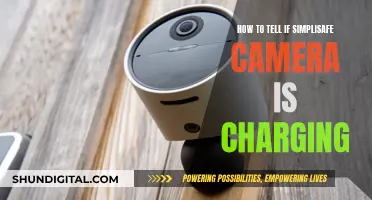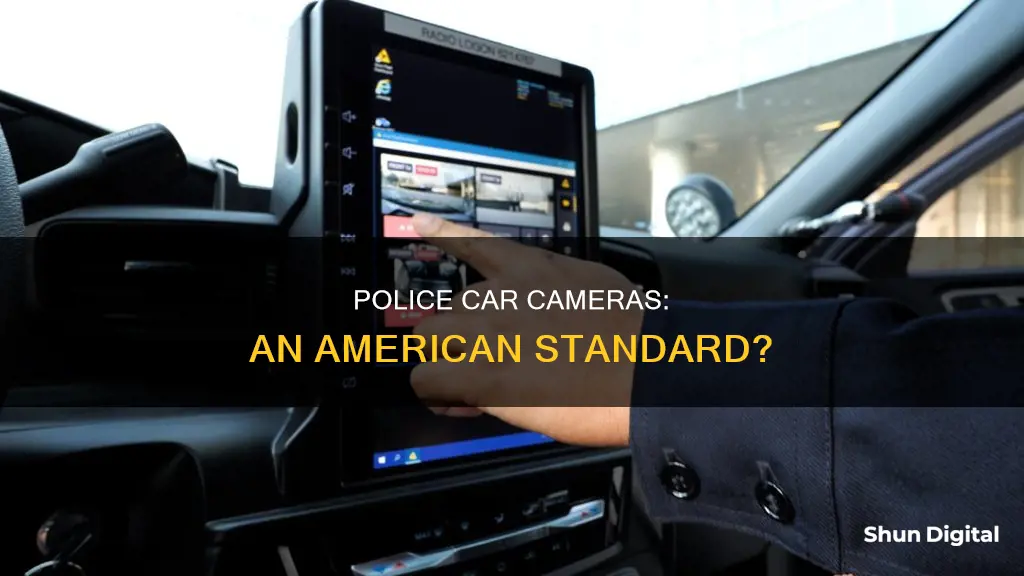
The use of cameras in police cars has become a standard practice in most US cities and states. In-car camera systems help record events in real-time, store them, and upload them to the proper quarters. They also help the police establish an offence and identify offenders by recording events as they happen. In some cases, cameras in police cars can be used to issue speeding tickets. The installation of cameras in police cars has improved the way police work is performed, keeping both citizens and officers safe.
| Characteristics | Values |
|---|---|
| Percentage of state patrol vehicles with in-vehicle camera systems in 2000 | 11% |
| Percentage of state patrol vehicles with in-vehicle camera systems now | 72% |
| Who activates the camera | Depends on the police car; some are hardwired to turn on automatically when the car starts or when emergency lights and sirens are turned on, while others need to be manually activated by an officer |
| Purpose of cameras | To provide an objective account of what happened during an incident, record events in real-time, store and upload footage to the proper quarters, and protect both officers and citizens |
| Camera placement | On the dashboard, outside the front and back windshields, mounted on the sides of the car and built into the light bar, and inside the car to monitor prisoners |
| Number of cameras | Up to five in some cases |
| Camera capabilities | High-definition video, high-fidelity audio, panoramic view, automatic license plate reading, and automatic wireless uploading of data |
| Data storage | Requires the purchase of servers and infrastructure to retain data according to state standards |
What You'll Learn
- Police car cameras are triggered by events such as turning on emergency lights or speeding
- Cameras can be manually activated by officers, but some start automatically
- Cameras provide an objective account of events, protecting both officers and citizens
- In-car camera systems record, store and upload footage, which can be used as evidence
- Police car cameras can also be used to monitor officer activity and increase accountability

Police car cameras are triggered by events such as turning on emergency lights or speeding
In the last two decades, the world of law enforcement has seen a surge in new technologies, such as police car cameras, body cameras, and high-tech squad cars. In 2000, only 11% of state police and highway patrol vehicles had in-vehicle camera systems, but now, almost 72% of all state patrol vehicles utilize this technology.
Police car cameras are hardwired into a vehicle's electrical systems, allowing them to be activated by programmed triggers. These triggers can include events such as turning on emergency lights and sirens, speeding, or opening the rear doors. For example, the police department in Palo Alto, California, has equipped its fleet with a multiple-camera video system that automatically starts recording when the emergency lights are on or when the car exceeds a certain speed. This technology ensures that incidents are captured on camera, providing an objective record of events and protecting both officers and citizens.
In some cases, police car cameras may also be manually activated by officers. Additionally, some cameras are set to turn on as soon as the car is started, ensuring that every incident is recorded regardless of whether the camera was manually activated or not. This constant recording capability provides a comprehensive view of incidents, enhancing officer safety and transparency in law enforcement agencies.
The integration of body-worn cameras with in-car camera systems further enhances the effectiveness of these technologies. For instance, Pro-Vision's in-car camera system can automatically trigger body cameras within a 30-foot range to start recording simultaneously when the vehicle's lights or other triggers are activated. This simultaneous recording provides a more complete view of an incident, capturing critical evidence and improving the overall safety of law enforcement operations.
The use of police car cameras and associated technologies has brought about significant changes in police work, improving accountability, evidence collection, and the overall safety of both officers and the public.
Blackvue Cameras: Where Are They Manufactured?
You may want to see also

Cameras can be manually activated by officers, but some start automatically
In the last two decades, there has been a surge in the use of technology in law enforcement. Police car cameras are now a standard feature in most US cities and states. These cameras are useful for capturing crucial events and incidents, and they can also help to protect both officers and citizens.
The cameras in most police cars are turned on while driving, and some models turn on automatically once the car starts. In other cases, cameras can be manually activated by officers. For example, in Palo Alto, California, the police department's fleet of 26 cars is equipped with a five-camera video system that automatically records video as soon as the car is turned on. However, audio recording is only activated when an officer pushes an event record button or when the system automatically goes into event mode due to certain triggers, such as the emergency lights being turned on or the car exceeding a certain speed.
The ability to manually activate cameras can be important in situations where an officer wants to ensure that a specific incident or interaction is recorded. This can include traffic stops, interactions with citizens, or any other event that the officer deems relevant or important. By manually activating the camera, the officer can ensure that the encounter is captured on video, providing an objective record of what transpired.
While some cameras are manually activated, others are hardwired into the vehicle's electrical systems and can be triggered by specific events or actions. For instance, some cameras are set to automatically start recording when a police officer turns on the emergency lights and siren. This automatic triggering ensures that critical situations are captured on camera, even if the officer doesn't have the opportunity to manually activate the camera.
The combination of manual and automatic activation ensures that police car cameras can effectively capture a wide range of situations. This not only helps in evidence collection and incident analysis but also promotes transparency and accountability in law enforcement.
Streaming Your Camera to Your Computer: The Finepix Way
You may want to see also

Cameras provide an objective account of events, protecting both officers and citizens
In the last two decades, the world of law enforcement has seen a surge in technologies such as police car cameras, police body cameras, and high-tech squad cars. These advancements aim to keep both officers and citizens safe by providing an objective and unbiased account of events.
Police car cameras are often hardwired into the vehicle's electrical systems, allowing them to activate based on specific triggers. For instance, turning on emergency lights and sirens may automatically trigger the camera system to start recording. Some cameras are even set to turn on as soon as the police car is started, ensuring that every incident is recorded, regardless of whether the officer remembers to activate the camera manually.
The presence of these cameras provides an independent and objective record of what transpires during police encounters. They capture events as they happen in real-time, providing an invaluable perspective that neither body cameras nor eyewitness accounts can offer. This is especially crucial in situations where there are no other officers present to corroborate an officer's actions.
The footage obtained from these cameras can be used as evidence in court, increasing accountability and transparency. It protects officers from frivolous complaints and safeguards citizens from potential misconduct. Additionally, the cameras can assist in analyzing and providing clarity to situations, ensuring that there is no room for controversy or equivocation regarding the details of incidents.
Furthermore, police car cameras can have specialized features, such as automatic license plate recognition, which aids in identifying vehicles of interest and locating suspects. This technology has proven effective in solving crimes and protecting the public.
Mastering Adjustment Brush Undo in Camera Raw
You may want to see also

In-car camera systems record, store and upload footage, which can be used as evidence
In-car camera systems have become increasingly common in police vehicles over the last two decades. These systems are able to record, store, and upload footage, which can be used as evidence. This technology has changed the way police work is performed, keeping both citizens and officers safe.
In-car camera systems can be triggered to start recording in a number of ways. Some cameras are programmed to activate based on certain triggers, such as when a police officer turns on their emergency lights and siren. In other cases, an officer may need to manually activate the camera. Some cameras are even set to turn on automatically as soon as the car is started, ensuring that every incident is recorded.
The footage captured by these in-car camera systems can provide an objective and unbiased account of what happened during a particular incident. It can be used to reconstruct events, determine fault, and identify key details that may have been missed or forgotten. This includes information such as traffic light colors, vehicle speeds, and road conditions.
In addition to providing valuable evidence, in-car camera systems also offer centralized storage for digital evidence. This means that footage from multiple body-worn and vehicle cameras can be kept in one place, along with metadata and information from other connected devices. This centralized storage makes it easier for law enforcement to securely offload data, ensuring reliable access to important evidence.
The use of in-car camera systems provides numerous benefits to law enforcement, improving the safety of both officers and the public. By recording and storing footage, these systems offer a valuable tool for evidence collection and can help to protect the rights of all involved parties.
Mastering Manual Focus: Forcing Your Camera to Focus
You may want to see also

Police car cameras can also be used to monitor officer activity and increase accountability
In the last two decades, the world of law enforcement has evolved significantly, with technology becoming increasingly integral to policing. The use of police car cameras is one such example of this evolution. These cameras are capable of capturing comprehensive video footage, providing an objective account of incidents, and enhancing the safety of both officers and citizens.
One of the key benefits of police car cameras is their ability to monitor officer activity and increase accountability. The cameras provide an independent and objective record of an officer's encounters, which can be used to corroborate their accounts of events. This not only protects officers from frivolous complaints but also holds them accountable for their actions, promoting transparency and legitimacy in law enforcement.
The video footage captured by police car cameras can be used as evidence in court proceedings and investigations. It helps to document the occurrence and nature of crimes, strengthen prosecution cases, and lead to higher numbers of guilty pleas. Additionally, the presence of cameras can have a civilizing effect on both officers and citizens, improving interactions and preventing situations from escalating to the use of force.
The use of police car cameras also offers training opportunities for law enforcement agencies. Footage from the cameras can be reviewed by trainers and executives to assess officer activities and behaviour, advance professionalism, and implement new strategies. This can lead to improved policing practices and increased public trust in law enforcement agencies.
Furthermore, police car cameras can provide critical evidence to support investigations and prosecutions. With high-definition video and high-fidelity audio, these cameras ensure that no detail is missed. The footage can be used to capture suspect vehicles, monitor prisoner activity, and provide a broad view of the activity surrounding the police vehicle.
In conclusion, police car cameras serve as a valuable tool for monitoring officer activity and increasing accountability. They provide an objective record of incidents, protect both officers and citizens, and promote transparency and trust in law enforcement agencies. By embracing this technology, police departments can enhance their effectiveness and better serve the communities they protect.
Dual Camera Mode: Capturing the World in New Ways
You may want to see also
Frequently asked questions
Yes, most police cars in the US have video cameras installed.
Police cars can have cameras that record the front and back of the car, as well as the sides. Some police cars also have cameras that are part of an automatic license plate reader (ALPR) system.
Some police car cameras are hardwired into the vehicle's electrical systems and can be triggered by certain events, such as the police officer turning on their emergency lights and siren. Other cameras start recording automatically when the car is turned on.
Police car cameras provide an independent, objective record of what the officer encounters. The footage can be used as evidence in court and to increase accountability by monitoring officer activity.
On average, police cameras are believed to be able to see as far as 100 feet back, but this depends on the quality of the camera. Specialized cameras, such as those used in ALPR systems, can read a license plate from up to 150 feet away.



